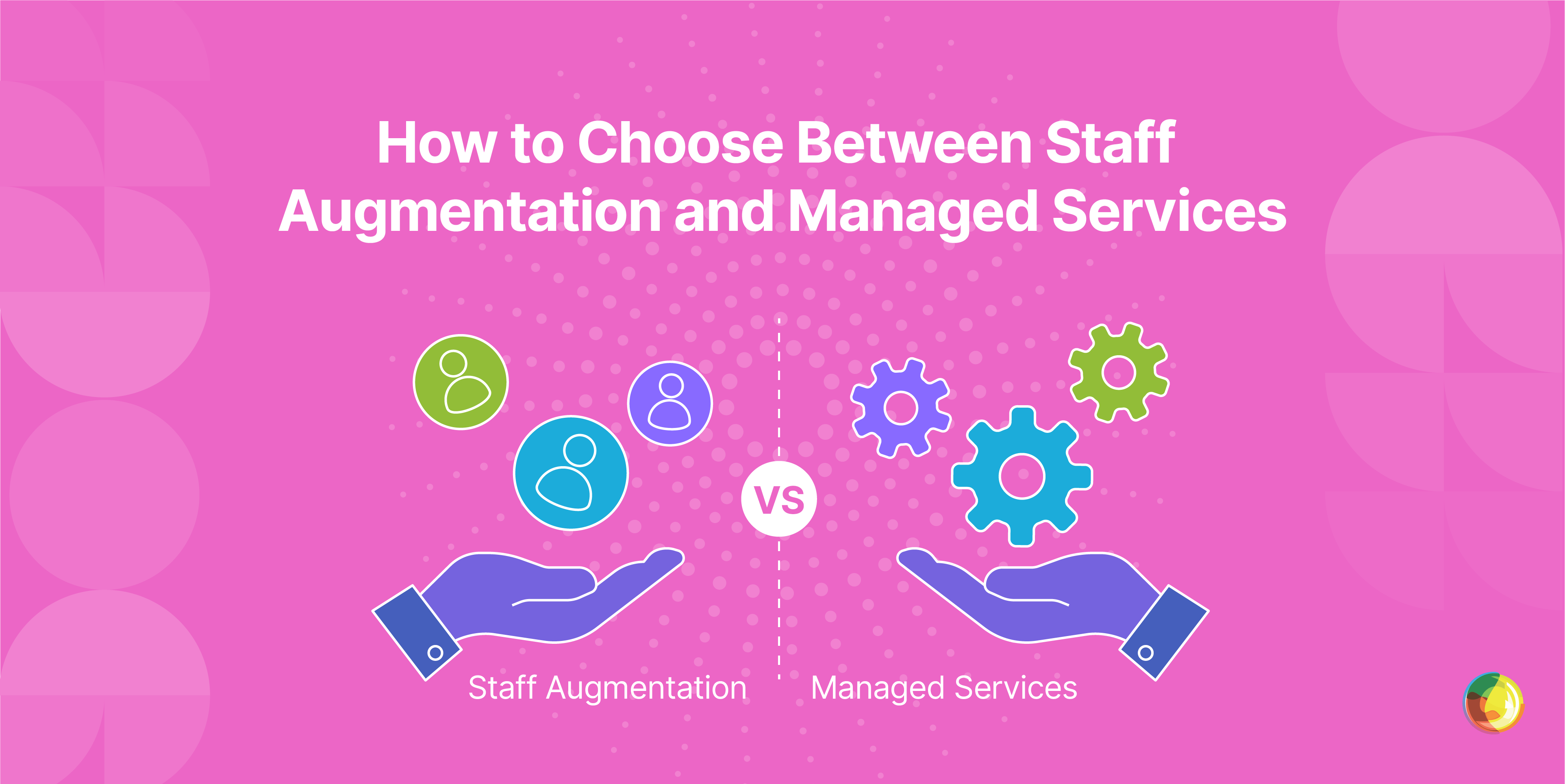How to Choose Between Staff Augmentation and Managed Services
Learn the pros, cons, and key decision factors to help you find the right outsourcing model for your next WordPress project.

Table of Contents
Key Takeaways
- Choose based on timeline: Staff augmentation suits short-term projects (3-6 months), while managed services work better for ongoing operations (12+ months).
- Control comes with trade-offs: Staff augmentation gives you direct control but requires heavy management; managed services reduce oversight but limit flexibility.
- Budget predictability matters: Staff augmentation offers pay-as-you-go flexibility with variable costs; managed services provide fixed monthly fees but watch for hidden charges.
You’re staring down a big outsourcing call: do you stick with staff augmentation for hands-on control, or go the managed services route for plug-and-play efficiency? It’s more than a workflow preference; this choice will shape your:
- Budget and how predictable it is.
- Delivery speed and project outcomes.
- Broader digital transformation game plan.
Each model shines in the right context, with distinct advantages depending on your goals. This guide breaks it all down – clear definitions, honest pros and cons, and straight-talking selection criteria.
You’ll also get a tried-and-tested decision framework, plus insight into why more businesses are blending both models to stay agile and get the best of both worlds.
Understanding the Differences Between Staff Augmentation and Managed Services
What Is Staff Augmentation?
Staff augmentation is when companies hire temporary workers to fill skill gaps or support projects. These professionals slot in under your direction, working as part of your organization while officially staying on the outside.
You get the skills, they follow your lead. That means you stay in control of:
- Project strategy and overall direction.
- Day-to-day priorities and delivery pace.
- Tools, processes, and ways of working.
It’s a setup built for agility. You can bring people in on hourly rates, day rates, or short-term project contracts. Ideal for moments when you need high-level expertise, like a WordPress migration specialist for a quarter, or a website performance expert to sharpen things up before launch.
What Are Managed Services?
Managed services is a hands-off outsourcing model where an external provider takes full ownership of specific business functions. From strategy and execution to day-to-day upkeep, managed service providers (MSPs) handle the lot, freeing up your team to focus on the bigger picture.
The key difference? It’s all about outcomes, not hours. MSPs are on the hook for delivering results. That means:
- Hitting agreed business goals.
- Meeting performance targets.
- Keeping service quality consistently high.
These priorities are baked into formal Service Level Agreements (SLAs), complete with clear metrics and uptime guarantees.
Pricing models vary: you’ll often see monthly retainers (great for budgeting), per-user rates (perfect for scaling), or tiered packages matched to your needs. Unlike time-based staff augmentation, managed services give you end-to-end solutions at a set cost.
Pros and Cons of Staff Augmentation
Pros
Full control: Staff augmentation puts you firmly in the driver’s seat. You stay in charge of the team, the direction, and the pace – so when plans change (as they always do), you can pivot fast without chasing sign-offs or battling red tape.
Scalable resourcing: Staff augmentation lets you flex your team size to match demand, helping you stay lean, productive, and on budget.
Cost-efficient for short term needs: Staff augmentation is a smart financial move for short-term projects. No need to pad your payroll with permanent hires. You simply bring in the right specialist for the right amount of time, and that’s all you pay for.
Smooth integration: Augmented staff slot into your:
- Existing teams.
- Day-to-day comms.
- Regular workflows.
No awkward workarounds or culture clashes, just swift and smooth collaboration.
Clear IP ownership: When it comes to IP? It’s all yours. Code, design, strategy – every bit of it stays in-house, with no murky licensing or split ownership to worry about.
Fast onboarding: While full-time hires can drag through months of hiring hoops, augmented pros can be onboard and up to speed within days. A huge win when you're chasing niche skills – like a WordPress whiz – especially with WordPress now powering 43.4% of all websites as of June 2025.
Cons
Management overhead: Your team leads now have to juggle managing temporary staff and their day jobs, which means less time for strategy and more time fielding Slack pings.
Knowledge drain: Once contracts wrap, those extra hands walk out the door, with all the know-how they picked up along the way.
Unpredictable costs: Hourly rates may look innocent upfront, but long stints (plus the hidden cost of managing them) can end up pricier than a managed service model.
Inconsistent performance: Some contractors perform like superstars; others… not so much. You can vet till you're blue in the face – consistency still isn’t guaranteed. Plus, since they’re task-focused rather than outcome-driven, accountability can feel slippery.
Security risks: Every temp you onboard is another potential weak point. Add in the time it takes to get them fully trained, and short stays can feel like high-effort, low-return investments.
Pros and Cons of Managed Services
Pros
Predictable monthly costs: Fixed-fee structures eliminate budget surprises, enabling CFOs to forecast accurately and allocate resources with confidence.
Comprehensive expertise: Rather than recruiting specialists for security, infrastructure, development, and maintenance, you can access an entire team of professionals through one partnership. This breadth proves invaluable for complex ecosystems requiring diverse skill sets.
Proactive maintenance: MSPs continuously monitor systems, identifying and resolving potential issues before they impact operations. This vigilance extends through:
- Performance optimization.
- Security threat detection.
- Capacity planning.
Clear accountability: SLAs establish measurable performance standards. When service levels dip, contractual remedies apply, creating genuine partnership incentives for consistent excellence.
Reduced management burden: your leaders focus on strategic growth initiatives while the MSP handles operational complexities.
Enterprise-grade tools: you can leverage the provider's existing technology stack to access tools and platforms without investing capital.
Continuous improvement: MSPs apply lessons learned across their entire client base.
Enhanced security posture: MSPs combine specialized compliance expertise with advanced threat management capabilities.
24/7 support coverage: ensure business continuity without overtime concerns.
Automated updates: regular technology patches are handled with zero fuss, which is crucial for platforms like WordPress that require frequent security updates.
Cons
Reduced direct control: you lose visibility over the day-to-day and can't pivot on a dime. When the market shifts, you’re filling out formal change requests instead of just getting things done.
Vendor lock-in risks: Swapping providers isn’t simple… or cheap. Once you're tightly coupled with their systems, you’re looking at:
- High switching costs.
- Risky, messy transitions.
- Technical headaches.
Standardized approaches: MSPs run lean by streamlining across clients. Great for them – less so for you, when your tailored processes get squeezed into a one-size-fits-all setup that dulls your edge.
Communication barriers: talking through account managers adds a game of telephone to the mix. Critical details go missing, and fixes take longer than they should.
Data security concerns: when outsiders handle your core operations, confidentiality questions inevitably creep in, no matter how many certifications they flash.
Cultural misalignment: what your MSP calls "best practice" might clash with how your team actually works, and even what you stand for.
Limited technical flexibility: want to try a new tool or tweak your setup? Good luck. You’ll need sign-off, extra fees, and probably a PowerPoint.
Dependency risks: when your provider holds the keys to key systems, any hiccup on their end could leave you stranded.
Hidden cost potential: those neat-sounding contracts are often peppered with extras – usage caps, out-of-scope surprises, and support premiums that quietly swell your spend.
Generic solutions: mass-market packages tend to overlook the nuances of your industry and the quirks that make your business tick.
Scope ambiguity: what’s included, what’s not, and who decides? Vague service agreements leave plenty of room for finger-pointing, scope creep, and invoice shock.
Comparing Staff Augmentation vs. Managed Services
Cost Considerations: Short-term vs. Long-term Projects
When it comes to cost, staff augmentation gives you short-term flexibility with pricing that shifts as you scale. Managed services, on the other hand, offer steadier, more predictable costs – ideal for long-haul operations. Each comes with its own way of measuring ROI, depending on your goals and timeline.
| Cost Factor | Staff Augmentation | Managed Services |
|---|---|---|
| Pricing Model | Pay-as-you-go (hourly/daily rates). | Fixed monthly retainers. |
| Typical Rates | $50–$199/hour on average, depending on expertise and location. | $100–$149/hour on average, depending on expertise and location. |
| Best For | Short-term projects (3-6 months). | Long-term operations (12+ months). |
| Budget Predictability | Variable costs, harder to forecast. | Predictable monthly expenses. |
| Hidden Costs | Recruitment fees, management overhead. | Setup charges, termination fees. |
| ROI Measurement | Project delivery success. | Operational efficiency gains and project delivery success. |
Control, Ownership, and Intellectual Property
With staff augmentation, you’re in the driver’s seat – full oversight, full IP ownership, no surprises. With managed services, although you're still steering the strategy, the day-to-day’s handed off. Just know: IP rights and compliance terms can vary, so read the fine print.
| Control Aspect | Staff Augmentation | Managed Services |
|---|---|---|
| Project Control | Complete direct control. | Strategic control, operational delegation. |
| IP Ownership | All IP remains with the client. | Most MSPs retain processes and code whilst the client keeps the data. |
| Team Management | Direct supervision of individuals. | Work through provider's managers. |
| Legal Agreements | Individual NDAs and IP assignments. | Master service agreements. |
| WordPress Specifics | Full ownership of custom code/plugins. | License and ownership terms vary. |
| Compliance Control | Client maintains all responsibility. | Shared or delegated responsibility. |
Security and Compliance Implications
Security-wise, staff augmentation means folding new talent into your existing protocols. Your team stays in the driver’s seat, and compliance stays your responsibility. Managed services, on the other hand, hand you enterprise-grade protection out of the box, with the provider taking the lead on compliance and automating the heavy lifting on security upkeep.
| Security Factor | Staff Augmentation | Managed Services |
|---|---|---|
| Security Model | Extend internal protocols to external staff. | Provider's enterprise-grade security. |
| Access Control | Direct system credentials required. | Work through secure interfaces. |
| Compliance Burden | The client bears full responsibility. | Provider shares/assumes compliance. |
| Security Certifications | Depends on individual contractors. | ISO, SOC, industry certifications. |
| Incident Response | Internal team coordination. | Dedicated incident management. |
| WordPress Security | Client manages all security updates. | Automated security patches included. |
Scalability and Flexibility Factors
Scalability’s where these two really part ways: staff augmentation lets you plug in exact skills one hire at a time, while managed services scale fast, flexibly, and globally – with ready-made teams and built-in bandwidth.
| Scalability Aspect | Staff Augmentation | Managed Services |
|---|---|---|
| Scaling Method | Add/remove individual contributors. | Adjust service tiers. |
| Time to Scale | 2-4 weeks average (recruitment required). | Days (once you have an existing agreement). |
| Skill Flexibility | Precise skill matching. | Broad capability pools. |
| Geographic Reach | Limited by local talent availability. | Global resource access. |
| Technology Pivots | Easy with direct control. | Guided by best practices. |
| Seasonal Needs | Requires new recruitment cycles. | Built-in elastic capacity. |
How the Two Models Stack Up
Neither model is a magic bullet; it all comes down to context. Staff augmentation shines when you need boots on the ground for short bursts of focused work. Managed services are built for keeping day-to-day operations running like clockwork.
Most businesses end up needing both:
- Hands-on control for high-stakes initiatives.
- Dependable cover for everyday tasks.
- Extra muscle when demand spikes.
The smartest play is a mix: staff augmentation for specialised bursts, managed services for the long haul. Together, they give you flexibility and staying power.
Partners like Multidots offer both – ideal when your WordPress needs swing between intense dev sprints and smooth, stable delivery.
Making the Right Outsourcing Decision
Six critical factors will steer you toward the best-fit outsourcing model:
- Project timeline is your starting point. Got a 3–6 month sprint? Staff augmentation fits the bill. Looking at year-long (or longer) operations? Managed services win on staying power.
- Management bandwidth shows how hands-on you can afford to be. A solid in-house PM team? Great. Staff augmentation works well. Short on internal capacity? Managed services can take the wheel and run with it.
- Budget needs shape how tightly you control spend. Staff augmentation means:
- Costs flex with project phases.
- You scale as needed, when needed.
- No scary long-term commitments.
Managed services offer neat, predictable monthly costs. Just keep an eye on those exit clauses.
- Expertise scope comes down to how wide your talent net needs to be. If you need a WordPress performance expert for a short-term fix, augmentation’s your friend. Need someone on hand for security, infra, and dev support – day in, day out? Managed services are the way forward.
- Compliance requirements lean heavily toward managed services when accreditations count. Most MSPs come armed with ISO, SOC, and other shiny badges. Staff augmentation, on the other hand, puts the compliance ball firmly in your court.
- Scalability timelines differ sharply. Managed services scale near-instantly by tweaking service tiers. Staff aug takes a little longer: around 2–4 weeks to recruit and onboard.
The bottom line: Use staff augmentation for short bursts of specialist firepower, especially when you’ve got the internal muscle to manage it. Opt for managed services when you want done-for-you delivery, stable spend, and more breathing room.
Want the best of both worlds? Go hybrid. Handle strategic WordPress migrations in-house and offload the everyday upkeep to free up time, focus, and brainspace.
How Multidots Elevates Your WordPress Projects with its Flexible Staffing Solutions
Multidots sidesteps the usual outsourcing headaches with a flexible engagement model backed by 90+ WordPress professionals. Whether you’re after staff augmentation now and managed services later, our team shifts gears without a hitch.
And yes, the results speak. Our website overhaul for a Social Media Intelligence Platform (under the News Corp umbrella) led to a 53% boost in page speed. That kind of technical uplift drives real business impact:
- Faster load times = better conversion rates.
- Core Web Vitals wins = stronger SEO rankings.
- Smoother UX = deeper user engagement.
But this isn’t your standard IT outsourcing. Multidots goes deep on WordPress, offering:
- Migrations from Drupal, Sitecore, and legacy platforms.
- Performance optimization for traffic-heavy sites.
- Enterprise builds that scale to millions of users.
- Comprehensive website development that covers everything from moderate customization to full-site redesigns.
- Ongoing maintenance to keep things secure and speedy.
Scalability is where we really shine. During migration crunch time, you can scale up with embedded specialists. After launch, dial things down and shift to managed services without skipping a beat. Ideal for teams navigating WordPress’s ever-changing landscape.
Whether you’re migrating thousands of pages or fine-tuning performance across global markets, the key is flexibility without compromise. That’s what our model is built for – scalable WordPress talent, on demand, with enterprise-grade reliability woven in.

Our support flexes to how you like to work. That means if you want full control while shaping your digital strategy, our augmented staff slot right into your team. Want to stay focused on growth while the backend runs like clockwork? Our managed services have you covered. Most clients land somewhere in the middle, owning the parts that matter most, while handing off the rest for smooth, efficient delivery.
Making the Right Choice: Multidots' Flexible Approach to Your WordPress Needs
The staff augmentation vs. managed services debate doesn’t have to be an either-or proposition. Multidots blends the best of both with a flexible, strategic hybrid model.
With deep enterprise expertise and a client list full of big-name brands, Multidots gets what matters to CMOs. Our services flex with your priorities, making sure every technical move pushes your business forward.
From early-stage ideas to design, build, and long-term support, we’ve got you covered. Kick off with expert augmentation for that complex migration, then switch to managed services to keep everything humming – same partner, smooth handover.
Chat to Multidots today to see how our adaptable model can supercharge your WordPress game.
Feel free to schedule a quick call with our team.
Contact Us
